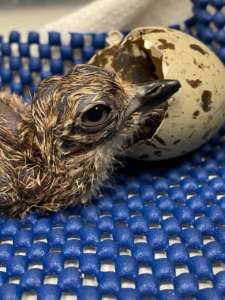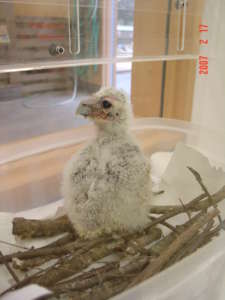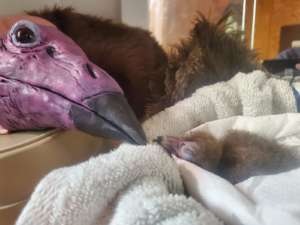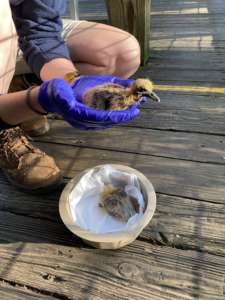Bird Breeding Season: Chicks
Lauren Wilson here, one last time to finish discussing the Bird Department’s breeding season. What happens after birds build nests and lay eggs? Chicks, of course! In this, arguably the cutest, blog, we will discuss everything chick-related, from hatching, hand-rearing versus parent-rearing, and what we do to set up the parents and the chicks for success.
 First things first, the chick must hatch out of the egg, and it is hard work! As the egg continues to develop, a pocket of air called an air cell forms that becomes larger closer to the hatch date. The first step in the hatching process involves the chick rotating into the correct position to hatch (head under right wing) and pushing through an internal membrane into the air cell. This is called an internal pip. At this point, the chick is breathing air but, even though the eggshell itself is porous and allowing for the exchange of gases, carbon dioxide builds up inside the air cell. This cues the chick to use a small point on its beak called an egg tooth, to break through the shell of the egg or to externally pip. The time between internal pip and external pip is generally between 12 and 36 hours. So, if we see via candling that a chick is internally pipped, we know that it will hatch soon.
First things first, the chick must hatch out of the egg, and it is hard work! As the egg continues to develop, a pocket of air called an air cell forms that becomes larger closer to the hatch date. The first step in the hatching process involves the chick rotating into the correct position to hatch (head under right wing) and pushing through an internal membrane into the air cell. This is called an internal pip. At this point, the chick is breathing air but, even though the eggshell itself is porous and allowing for the exchange of gases, carbon dioxide builds up inside the air cell. This cues the chick to use a small point on its beak called an egg tooth, to break through the shell of the egg or to externally pip. The time between internal pip and external pip is generally between 12 and 36 hours. So, if we see via candling that a chick is internally pipped, we know that it will hatch soon.
What happens if it takes longer than 12 to 36 hours? What happens if we see the chick breaking through the eggshell before breaking into the air cell? In these cases, the chick is usually malpositioned. Just like a human baby can be breached (feet first presentation), birds can be in all sorts of positions besides the normal one. Some can successfully hatch on their own and others need help from us. We call this process assist hatching. We use sterile tools to carefully remove pieces of membrane and eggshell from the chick to help it hatch. What happens if a chick doesn’t hatch at all? We examine every egg that doesn’t hatch and determine at what stage of development the embryo died. This helps us to determine what went wrong in development so we can improve the chances of success in the future.
Regardless of if eggs are hatching underneath their parents or with us after being artificially incubated, we then decide how the chicks will be reared. Will they be reared by parents, by foster parents, by us, or a combination? Once again, these decisions are made based on a variety of factors, with the history of the parents being most important. If the parents have a history of successfully raising offspring, we usually decide to let them raise their own chicks. If they don’t have a successful history, we may have a foster pair of birds raise their offspring or raise them ourselves. Finally, in some cases, we might do both by raising them for a week to 10 days before reintroducing them to their parents. We do this especially with first-time vulture or hornbill parents to ensure the chicks are healthy, giving a good feeding response, and are physically large enough that they will be okay if a new mom or dad accidentally steps on them. We did this most recently with our first ever lappet-faced vulture chick, Amari.
Now that we have chicks, the keepers must provide the right diet. How this is achieved depends on a variety of factors, including species behavior and what type of feeding strategy they use (e.g., insectivore, carnivore, frugivore etc.). A few examples of these include the wattled cranes, which have a pelleted diet crushed small enough for a chick to consume; the crested wood partridges, which have hardboiled egg added to their diet so the chicks have an extra source of protein; and the lappet-faced vultures, which are solely offered mice so it is easy and safe for the parents to feed to their chick. By far the most important diet item for most of the birds at Zoo Atlanta is insects. We feed a variety of insects, but almost exclusively feed mealworms to chicks. To ensure these mealworms are nutritionally complete, the Bird Team begins the process of gut loading them four days in advance. This means that we feed the insects a nutritionally complete diet that, in turn, makes the insects nutritionally complete for growing chicks!
Hand-rearing is the most challenging, but the most rewarding, aspect of the breeding season. Hand-rearing chicks takes a lot of time, resources, and planning to ensure success. Typically, the newly hatched chick(s) is placed in a special machine called a brooder. This machine allows us to keep the chick at a specific temperature and humidity. As the chick develops, it will utilize different substrates that mimic the nesting strategy used by its species. For instance, a hooded vulture chick may start out on a towel nest because these items are easily sanitized, but will graduate from small to large sticks so that its feet and legs can develop normally. During the hand-rearing process, diet type and timing of feeding are crucial and are oftentimes different than what the parents will do. In the case of carnivores, we cannot perfectly mimic how carnivorous birds shred the meat they feed their chicks, so we will usually feed baby mice instead of adult mice. With frugivores, we cannot mimic the process of consuming and regurgitating fruit to chicks, so we feed a specialty formula. We also want to time feeds so that the chick is getting enough food over the course of the day to gain weight, but not so much that it grows too fast or becomes impacted and cannot process food at all. Some chicks require feeding 10 times a day, once every two hours, from 6 a.m. to 12 p.m. … talk about a busy day!
 Finally, I would be remiss to not mention the amount of thought that goes into how we should rear a chick. Letting the parents or foster parents raise chicks is usually the best situation for the birds but, if the pair is new or has not been successful in the past, it can be risky. When establishing the history of a pair, the Bird Team will check on chicks and weigh them daily to confirm the parents are providing the necessary care. If they’re not, we have the option to supplementally feed them under the parents or, in worst case scenarios, we can remove them from their parents and hand-rear. Hand-rearing has its disadvantages too. The biggest one is the risk that the chick will imprint on people. Imprinting is the process by which an individual gains its sense of species identification, occurs during a critical period of development, and occurs more often in some species than in others. In many species of songbirds such as the white-headed buffalo weaver, imprinting is not a large concern. They integrate suitably with conspecifics (individuals of the same species) after being hand-reared. While it is vital to take steps against imprinting, such as rearing with clutch mates, if possible, most hand-reared songbirds will grow up eliciting the same behaviors as parent reared ones. In other species such as cranes and vultures, imprinting is a larger concern. They are prone to imprinting and grow up not eliciting the same behaviors as parent-reared ones. This is especially true with behaviors required for breeding success, like courtship, nest building, and raising chicks. But we can avoid imprinting when we hand rear by being quiet, utilizing puppets to prevent the chick from seeing keepers, and by raising it with other birds or in view of its parents.
Finally, I would be remiss to not mention the amount of thought that goes into how we should rear a chick. Letting the parents or foster parents raise chicks is usually the best situation for the birds but, if the pair is new or has not been successful in the past, it can be risky. When establishing the history of a pair, the Bird Team will check on chicks and weigh them daily to confirm the parents are providing the necessary care. If they’re not, we have the option to supplementally feed them under the parents or, in worst case scenarios, we can remove them from their parents and hand-rear. Hand-rearing has its disadvantages too. The biggest one is the risk that the chick will imprint on people. Imprinting is the process by which an individual gains its sense of species identification, occurs during a critical period of development, and occurs more often in some species than in others. In many species of songbirds such as the white-headed buffalo weaver, imprinting is not a large concern. They integrate suitably with conspecifics (individuals of the same species) after being hand-reared. While it is vital to take steps against imprinting, such as rearing with clutch mates, if possible, most hand-reared songbirds will grow up eliciting the same behaviors as parent reared ones. In other species such as cranes and vultures, imprinting is a larger concern. They are prone to imprinting and grow up not eliciting the same behaviors as parent-reared ones. This is especially true with behaviors required for breeding success, like courtship, nest building, and raising chicks. But we can avoid imprinting when we hand rear by being quiet, utilizing puppets to prevent the chick from seeing keepers, and by raising it with other birds or in view of its parents.
Fledging is the final stage in the chick rearing process, and refers to when the chicks leave the nest. This term almost exclusively applies to altricial chicks that, until this point, are confined to the nest. To fledge, an altricial chick must open their eyes, become more mobile, and grow their flight feathers. Even after all these developmental milestones, it might still take some time for them to feel confident enough to take that first step, flight, or, sometimes, not so graceful leap out of their nests! This is where the Bird Team focuses the most on the safety of the altricial chicks. We will drain large pools, place soft matting down on hard surfaces, and provide specialized perching so newly fledged chicks can get off the ground. The Bird Team’s observation skills also kick in to spot newly fledged chicks amongst the bushes and shrubs to ensure that the parents have also found them and are continuing to provide care.
And that’s it! Zoo Atlanta’s Bird Department breeding season in a nutshell. If you’ve stayed with me this long, thank you! I hope these blogs have piqued your interest in all things bird because, believe it or not, I have only skimmed the surface of bird breeding behavior and aviculture. I encourage you to look up courtship behaviors (birds of paradise are AMAZING), more nest types (did you know some nests float?), and all of the cute chick photos you can find … some of my favorite include jacanas, king penguins, and roseate spoonbills. But mostly I hope you gained a greater understanding of birds and an appreciation for the amount of planning and work that goes into caring for the birds here at Zoo Atlanta!
(Photos: Bird Team)
Lauren Wilson
Associate Curator of Birds

Connect With Your Wild Side #onlyzooatl